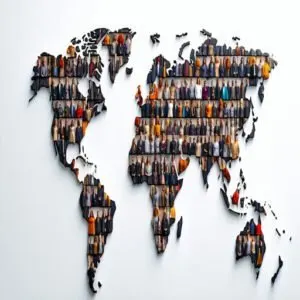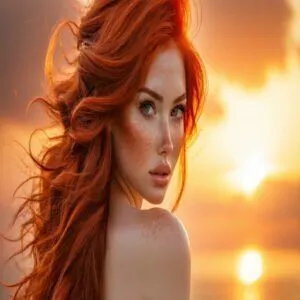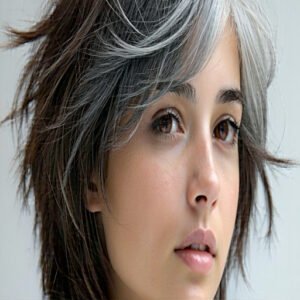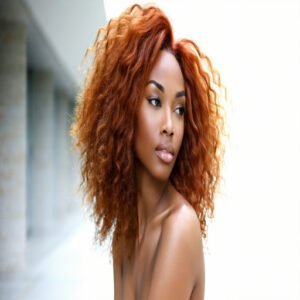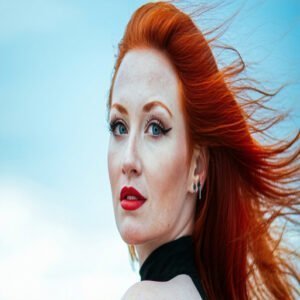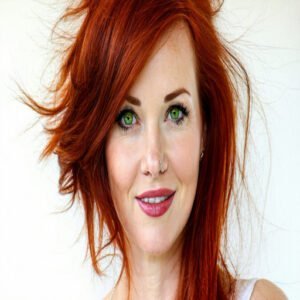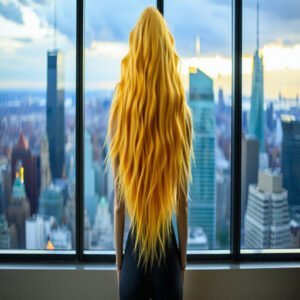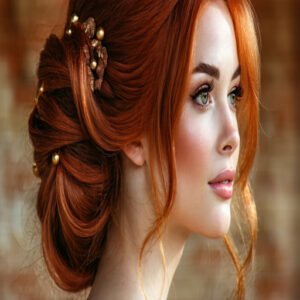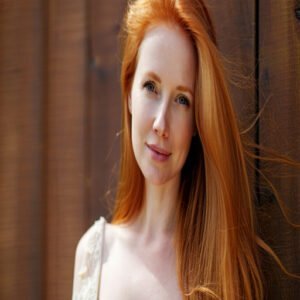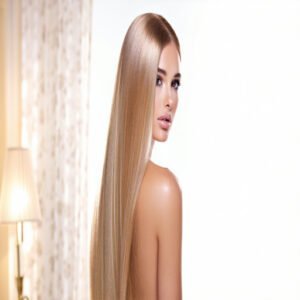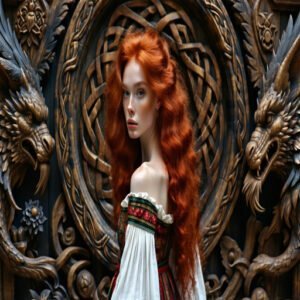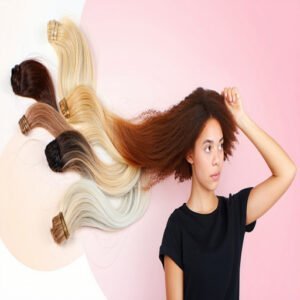This site is supported by our readers. We may earn a commission, at no cost to you, if you purchase through links.
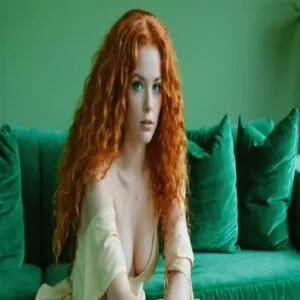 The rarest hair color in the world is natural red, appearing in just 1-2% of the global population.
The rarest hair color in the world is natural red, appearing in just 1-2% of the global population.
This fiery shade owes its rarity to specific variants in the MC1R gene, which control the balance of two pigments—eumelanin and pheomelanin.
To put it simply, red hair is like the unicorn of hair colors because both parents must pass down a recessive gene for it to appear.
While redheads may be scarce, combinations like red hair and green eyes are even harder to find.
Curious about the science behind these unique traits or how environment shapes hair color? Stay tuned!
Table Of Contents
- Key Takeaways
- Hair Color Distribution Across The Globe
- What is The Rarest Hair Color in The World?
- Science Behind Rare Hair Colors
- Rare Hair Color Combinations
- Hair Color Genetics and Inheritance
- Rarest Hair and Eye Color Combinations
- Factors Affecting Hair Color
- Rare Hair Color Examples
- Hair Color and Cultural Significance
- Determining Your Natural Hair Color
- Frequently Asked Questions (FAQs)
- What are the top 3 rarest hair colors?
- What is the rarest skin color?
- Which hair color is the least common?
- What is the 1st rarest hair color?
- Why are some hair colors rare?
- What is the most common natural hair color?
- Is red hair rare?
- What is the most common hair color in the world?
- What is the rarest type of blonde hair?
- What is the rarest hair color?
- Conclusion
Key Takeaways
- You’ll find red hair is the rarest natural hair color, appearing in just 1-2% of the global population due to a recessive gene in the MC1R variant.
- Pairing red hair with blue eyes is even more uncommon, occurring in only 0.17% of people worldwide—a true genetic rarity.
- Your hair color results from a mix of genetics, specifically dominant and recessive traits, and is influenced by levels of eumelanin and pheomelanin pigments.
- External factors like UV exposure, pollution, and aging can subtly change your natural hair color over time.
Hair Color Distribution Across The Globe
You’ll find black hair dominating 75-85% of the world’s population, while natural red hair appears in just 1-2% of people globally.
Your chances of having a specific hair color largely depend on your geographic location and genetic background, with black hair most common in Asia and Africa, while natural blonds cluster in Northern Europe.
Black Hair Prevalence
When you look at global hair color distribution, black hair dominates the scene, making up a striking 75-85% of the global population.
You’ll find this rich dark shade especially prevalent across Africa and Asia, where melanin levels reach their peak.
Studies show fascinating ethnic variations in hair density among black-haired individuals, with unique patterns across different populations.
The high eumelanin content in African hair creates those characteristic deep, dark shades you see worldwide.
Think of it as nature’s signature style—black hair transcends borders, connecting diverse cultures through shared genetic heritage.
Understanding hair color genetics is essential to appreciating the complexity of global hair color distribution and the factors that influence it.
Brown Hair Prevalence
While black hair dominates global statistics, brown hair takes second place, making up roughly 11% of the world’s hair color distribution.
You’ll find this versatile shade everywhere from European countries to Asian regions, showcasing remarkable hair color variation across different ethnic groups.
Brown hair genetics fascinate scientists, as global brown distribution patterns reveal how this trait spreads through populations.
From rich chocolate to light ash tones, brown shade diversity spans a stunning spectrum.
Research into ethnic hair trends shows that brown hair’s prevalence varies substantially by region, with some areas showing concentrations as high as 30% of the local population.
Blonde Hair Prevalence
Sunlight catches those rare light shades of natural blonde hair, a genetic treasure found in just 2% of the world’s population.
Your Nordic Features might reveal European Roots, especially in Northern regions where blonde genetics flourish.
Notably, only about 2% of the global population is naturally blonde.
Here’s what makes blonde hair color rarity fascinating:
- Only 1 in 50 people naturally showcase these golden strands
- Hair pigmentation varies substantially by region
- Natural blondes are more common than artificial ones think
- Blonde genetics require specific inherited traits
- Your natural blonde shade is truly one of earth’s rarer features
Red Hair Prevalence
While blonde hair turns heads, the rarest hair color crown belongs to natural red hair, found in a mere 1-2% of the world’s population.
Let’s explore what makes these flame-haired folks so unique:
| Region | Red Hair Percentage | Notable Traits |
|---|---|---|
| Scotland | 13% |
What is The Rarest Hair Color in The World?
You’ll be surprised to learn that natural red hair appears in just 1-2% of the world’s population, making it the rarest hair color on Earth.
If you’ve got naturally ginger locks, you’re part of a truly unique group that includes fewer people than those who can roll their tongues or write with their left hand.
Red Hair Rarity
Red hair, the rarest natural occurring hair colour, graces only 1-2% of the world thanks to fascinating Red Hair Genetics.
Its rarity comes from a genetic mutation in the MC1R gene that requires both parents to carry this recessive trait.
Here’s what makes redheads unique:
- Hair Pigmentation: High pheomelanin, low eumelanin levels.
- Cultural Myths: From witches to warriors, legends abound.
- Distinctive Redhead Traits: Higher UV sensitivity.
- Rare Coloration Magic: Fiery hues like copper and auburn!
Blonde Hair Rarity
Standing out in a crowd? That’s the magic of rare blondes, with just 3% of people sporting this striking hue.
From icy tones to golden Blonde Shades, its allure lies in unique Hair Pigmentation and Blonde Genetics.
Whether you’re pondering, "Is natural blonde hair rare?" or cherishing this tone, its Color Variation spans timeless beauty to modern trends, making it unforgettable.
Gray Hair Rarity
Regarding gray hair, it’s less about being on the list of the rarest natural occurring hair colours and more about its fascinating role in hair color rarity.
While it’s common with age, premature graying stands out as a unique phenomenon influenced by genetics and environmental factors.
Here’s what you should know:
- Gray Hair Causes: From genes to stress, multiple factors play a role.
- Hair Graying Patterns: Often mirrors ancestry trends.
- Statistics: Premature graying affects 1 in 5 under 30.
- Aging Effects: A natural embrace or hidden by dye.
Science Behind Rare Hair Colors
When you think about rare hair colors, it’s all about science and genetics working together in surprising ways.
Your hair’s unique shade depends on melanin levels, genetic mutations, and the interaction of pigments like eumelanin and pheomelanin.
Genetics of Hair Color
Hair color genetics is all about the interplay of gene expression and melanin production.
Your unique shade is shaped by genetic coding, with dominant and recessive color inheritance deciding your strands’ story.
Mutations create rare hair traits, like the rarest hair color, red.
Families often pass down fascinating genetic hair traits, revealing connections and histories etched into your roots—literally a science-backed family tree!
Melanin and Hair Color
Hair color genetics owes it all to melanin, the pigment production powerhouse.
This natural molecule decides everything—from the soft golden hues of blondes to deep ebony locks.
For truly black hair, high eumelanin levels are essential, as detailed in this guide to black hair color.
Melanin levels dictate color intensity, while its distribution sculpts your unique shades, think of it as your hair’s artist, mixing eumelanin types and hair pigment types for stunning results.
Plus, it’s not just about beauty—melanin protects hair against sun damage.
Eumelanin and Pheomelanin
Your hair’s shade is all about melanin production and the balance of two key hair pigment types: eumelanin and pheomelanin.
Eumelanin delivers rich black or brown hues, while pheomelanin sprinkles in red and orange tones.
Their pigment interaction creates endless color variation, from deep brunettes to fiery reds.
This genetic influence is why natural hair colors are so unique—and some are among the rarest hair colors!
Rare Hair Color Combinations
Some hair color combinations are so rare they can feel almost mythical—like red hair paired with blue eyes, seen in only 0.17% of the population.
These unique pairings happen due to specific genetic traits, making them fascinating examples of how genes create features you don’t see every day, which can be considered rare.
Red Hair and Blue Eyes
If you’ve got red hair with blue eyes, you’re rocking one of the rarest natural occurring hair colours in the world.
This combo—a true genetic lottery—requires recessive traits from both parents, making it as rare as spotting a unicorn.
Red hair genetics and blue eye rarity stem from unique genetic expression tied to hair pigmentation and eye color variance, leaving this duo as a standout among rare hair color combinations.
Blonde Hair and Blue Eyes
Blonde hair with blue eyes is one of the rarest natural hair color combinations, often tied to Nordic features and unique genetic traits.
It’s mostly seen around Northern Europe, particularly near the Baltic Sea.
This striking duo comes from recessive genes affecting hair pigmentation and eye color.
Curious about this rarity? Here are five facts:
- Requires two recessive genes.
- Found mainly in Nordic populations.
- Linked to fair skin.
- Influenced by melanin levels.
- A rare symbol of genetic diversity.
Understanding the best hair color options is essential for individuals with blue eyes to find a suitable and complementary shade.
Black Hair and Blue Eyes
Ever think about how rare black hair and blue eyes are together?
It’s one of the rarest hair color combinations in the world.
While black hair dominates globally, blue-eyed genetics are mostly tied to populations near the Baltic Sea.
This mix is like spotting a unicorn—unexpected and unforgettable.
Trait
| Prevalence |
|---|
| Black Hair |
This rare eye combination happens when contrasting hair pigmentation and eye color meet—a true genetic masterpiece!
Hair Color Genetics and Inheritance
Your hair color isn’t just a simple trait—it’s written in your DNA.
This is shaped by dominant and recessive genes passed down from your parents.
These genetic patterns can lead to common shades like brown or rare ones like red, depending on the unique mix you inherit.
Dominant and Recessive Traits
In the context of hair color, genetic influence is a fascinating game of dominance and subtlety.
Dominant traits act like bold brushstrokes, shaping hair pigmentation with darker colors like black and brown.
Meanwhile, recessive genes are the quiet artists, only expressing themselves when paired together—think blondes or the incredibly rare redheads.
This interplay gives us the rarest natural occurring hair colors, showcasing stunning color variation across the globe.
So, whether it’s genetics giving us fiery red or cool blonde locks, understanding these genetic traits reveals nature’s striking inheritance patterns!
Inheritance Patterns
If you’ve ever wondered how you ended up with your unique hair color, it’s all about inheritance patterns woven into your DNA.
Your parental influence and recessive genes play a big role in passing down genetic traits, creating countless possibilities.
Your family history acts like a treasure map of hair pigmentation, combining inherited characteristics from both parents.
It’s a bit of a genetic lottery, with mutations sometimes producing rare hair phenotypes, like the rarest hair color, that make you one-of-a-kind!
Genetic Variation
Genetic mutations make hair pigmentation a lively canvas of surprises.
Thanks to DNA variance, you might carry a hidden hereditary trait for rare hair colors like red.
The MC1R gene, famous for influencing red hair, plays a starring role in the genetics of hair color.
Evolution thrives on unpredictability, and gene expression guarantees every strand tells a story.
Who knows, your ancestry could hold the key to the rarest hair color!
Rarest Hair and Eye Color Combinations
You might think rare hair colors are uncommon, but pairing them with certain eye colors takes uniqueness to another level.
Red hair with green eyes and blonde hair with amber eyes are some of the rarest combinations, each influenced by complex genetic factors.
Red Hair and Green Eyes
If you’re into unique traits, the combination of red hair and green eyes is a showstopper.
With only about 2% of the population sporting this super rare pairing, it’s like finding a four-leaf clover.
This rarest natural occurring hair colour and eye combo pops up in genetic stories tied to Ireland, but its roots weave through Nordic history too.
The striking mix of red hair genetics and green eye rarity isn’t just eye-catching – it’s a genetic marvel tied to rare pigmentation.
- Rarest hair color paired with rare eyes
- Tied to fascinating genetic expressions
- A standout in rare eye combinations
- Often depicted in folklore
- Makes genetics feel magical
Blonde Hair and Amber Eyes
Amber tones paired with blonde hair? That’s genetic gold!
With blonde genetics in just 2% of the population and amber eyes in 5%, this rare combo deserves attention.
Finding the best hair color for blue eyes can be tricky, but amber eye pigmentation offers a warm, golden-brown shimmer that enhances the hair’s shine and color depth.
Forget blonde hair and blue eyes or brown hair and amber eyes—this duo tops rarest hair color statistics.
Curious? Search rare hair colors with names, and you’ll realize this pairing is a true gem of human diversity.
Factors Affecting Hair Color
You mightn’t realize it, but your hair color can change over time due to factors like aging, sunlight, or even hormonal shifts.
These influences, combined with genetics, determine how rare or common your natural shade truly is.
Environmental Factors
Environmental circumstances can mess with rare hair colors, gradually changing your hair’s natural hue.
Over time, external factors like UV radiation, air pollution, and heat exposure impact pigment levels, leading to fading or dullness.
Sometimes it’s like your hair’s up against the elements every day!
- UV Radiation: Pheomelanin fades, lightening tones.
- Air Pollution: Strips shine, weakens strands.
- Heat Exposure: Porous, brittle hair develops.
- Water Quality: Mineral buildup alters tones.
- Climate Change: Stress weakens pigmentation.
Hormonal Changes
Your hair isn’t immune to hormonal chaos.
Estrogen levels, pregnancy hormones, or even the menstrual cycle can subtly tweak its shade.
Thyroid impact or adrenal effects might dull or deepen tones, while stress can fast-track grays.
These shifts aren’t rare – they’re a part of life’s natural rhythm.
Changing colors might feel like discovering rarest natural occurring hair colours, but let’s be honest – rarest hair color natural?
That’s still genes’ job.
Aging and Hair Color
Aging works its magic on your hair through the graying process, thinning strands, and gradual color fading.
It’s all about pigment loss—melanin production slows, leaving behind those “natural highlights” we call gray hair.
Age-related changes aren’t just about looks; stress can accelerate gray growth and even hair thinning.
While rare hair colors remain among the rarest natural occurring hair colours, gray is surprisingly universal.
Embrace life’s phases or explore treatments to manage the shift, as hair color statistics remind us change is inevitable!
Rare Hair Color Examples
You’ve probably seen rare hair colors that make you do a double take, like fiery copper red or striking strawberry blonde.
These natural shades, like ginger red and bright blonde combinations, highlight just how unique genetic expression can be, with striking strawberry blonde being a notable example.
Copper Red Updo
Copper red updos celebrate the fusion of rarest natural hair color and timeless elegance.
These fiery Copper Locks are perfect for making a statement at any event.
For a flawless style:
- Create volume with loose waves or curls.
- Enhance with accessories like gold pins.
- Use sulfate-free products to keep Red Tones vibrant.
- Add subtle Copper Highlights for depth.
Maintaining vibrant copper hair requires understanding copper hair dye options.
Red Updos radiate charm, proving why copper red is among rare hair colors.
Ginger Red Natural Hair
That fiery ginger red? It’s one of the rarest natural occurring hair colours, thanks to genetics and its stunning vibrancy.
Packed with high pheomelanin and low eumelanin, ginger tones glow with natural highlights and copper shades.
This red hair rarity requires two recessive genes, emphasizing its exclusivity.
For those interested in achieving this unique color, understanding Ginger Hair Dye options is essential.
| Fun Fact |
|---|
| Pigment Balance |
red hair shades.
red hair rarity explained.
Interested in embracing red hair care? You’re not alone!
Straight Blonde Balayage
Straight blonde hair with a blonde highlights balayage technique creates a soft, sun-lit glow that’s undeniably radiant.
This look works wonders on various hair textures, offering effortless elegance.
But don’t forget—color maintenance is key to keeping it stunning.
Regular touch-ups guarantee your rare hair colors with names like platinum or honey blonde stay vibrant.
Whether sleek or textured, the styling options for this universally admired blend are truly endless.
To achieve the perfect blonde shade, understanding blonde hair dye options is vital for a successful color transformation.
Hair Color and Cultural Significance
Hair color doesn’t just affect appearance—it’s linked to traditions, symbolism, and even stereotypes in many cultures.
From fiery red hair symbolizing power in Celtic lore to blonde hair representing beauty in Western media, every shade carries its own story.
Cultural Associations
Behind every strand is a story.
Hair color connects us to ethnic identity and heritage, shaping perceptions through social norms and beauty standards.
While redheads, the rarest hair color group, stand out for their fiery uniqueness, blonde shades face enduring hair stereotypes.
Across cultures, your hair can signal style or status, proving these cultural associations are more than skin—or scalp—deep.
Historical Significance
Throughout history, hair color has carried meaning that’s as bold as the shades themselves.
Ancient civilizations like Egypt used hair color to signal rank, with elites favoring certain pigments.
Ever wonder when hair dye history began?
Egyptians were among the first, using henna to enhance their locks.
- Vikings and Red Hair: In Norse mythology, fiery red locks symbolized power and fate.
- Medieval Trends: Blonde was a star in religious art, representing purity or divinity.
These historical trends remind us how cultural heritage shaped the perception of even the rarest natural occurring hair colours.
Social Perception
Stereotypes have a big say in how society views unique hair colors.
If you’re a redhead, you’ve probably heard the “temperamental” label, while blondes get tied to outdated “less intelligent” jokes.
Brown-haired folks are seen as reliable, and black hair holds a mysterious aura.
These perceptions reflect social bias, not truth.
Beauty standards often shape how we judge rarest natural occurring hair colours, fueling public opinion.
The rarest hair color shades grab attention but also come with cultural views that influence acceptance.
In the end, stereotypes highlight society’s quirks, not its facts.
Determining Your Natural Hair Color
Figuring out your natural hair color might sound simple, but genetics, age, and environmental factors can complicate things.
If you’ve dyed your hair or spent a lot of time in the sun, tracing back to your original shade could feel like solving a small mystery.
Genetics and Natural Hair Color
Ever wondered why your hair is its unique color.
It’s all about genetic coding.
Your hair’s shade is shaped by melanin production—the balance of eumelanin (dark pigments) and pheomelanin (lighter pigments).
Genes like MC1R lead the charge in creating rare traits like red or blonde hair.
Curious? Here’s how it works:
- Melanin levels control shades, from deep black to rare blondes.
- Color inheritance combines parental traits.
- DNA expression reveals surprising, rare genetic traits.
Environmental Influences
Your surroundings subtly influence your hair’s shade, even if the rarest natural occurring hair colours owe much to genetic mutation.
UV exposure lightens hair by breaking down melanin, while air pollution dulls shine and vibrancy, and water quality, like hard water, can affect texture and color.
Meanwhile, temperature effects and shifts from climate change influence hair’s condition over time.
Curious? Here’s how it breaks down:
| Example Impact |
|---|
| UV Exposure |
Hair Color Testing
Uncovering your natural hair color isn’t rocket science—it’s all about using the right tools for hair color testing.
Whether you’re curious about the rarest natural occurring hair colours or simply confused about your shade, here are a few ways to nail it:
- At-home kits: Perfect for quick pigment testing and exploring undertones.
- Professional consultation: Experts combine shade identification with skin tone matching to find your perfect fit.
- Digital tools: Online apps and resources make rare hair color confirmation a breeze.
Ever wondered if your tint hides clues to the rarest natural color of hair? Analyzing can be downright fun!
Understanding natural hair maintenance strategies is key to preserving your natural color and achieving vibrant locks.
Frequently Asked Questions (FAQs)
What are the top 3 rarest hair colors?
Only 1-2% of people have red hair, making it the top rarest color.
Natural blonde claims the second spot at 2-3%.
The rarest tone? Strawberry blonde—a delicate mix of both.
What is the rarest skin color?
Skin color varies widely, but the rarest is often considered albinism.
It results from little or no melanin production, leading to very light skin, hair, and eyes.
Albinism affects roughly 1 in 20,000 people worldwide.
Which hair color is the least common?
The least common hair color is red, showing up in just 1-2% of the world’s population.
It’s caused by a recessive gene, making it an exclusive club.
Pair it with blue eyes? Jackpot rarity!
What is the 1st rarest hair color?
About 1-2% of people have red hair, making it the rarest natural color worldwide.
Since it’s recessive, both parents need the gene.
Pairing it with blue eyes? That’s an ultra-rare jackpot combo!
Why are some hair colors rare?
It boils down to genetics and the expression of specific genes. Red hair, for instance, requires both parents to carry and pass on the gene for it to show up.
What is the most common natural hair color?
It’s almost unfair how black hair steals the show as the most common natural hair color, claiming dominance with 75-85% of the global population.
It’s not just common—it’s universal, packed with eumelanin.
Is red hair rare?
Yes, red hair is rare.
Only about 1-2% of the world’s population has it.
Since it requires a specific recessive gene from both parents, it’s like winning the genetic lottery for fiery locks.
What is the most common hair color in the world?
The world’s most common hair color is black—no surprise since it’s found in 75-85% of people globally.
It’s rich in eumelanin, making it darker and most prevalent in Asia and Africa.
What is the rarest type of blonde hair?
Strawberry blonde takes the crown as the rarest type of blonde hair.
It’s a stunning mix of blonde and red tones, relying on specific genetic combinations that only a tiny percentage of people inherit.
What is the rarest hair color?
Red hair takes the crown as the rarest, showing up in just 1-2% of people.
But pairing red hair with blue eyes? That’s hitting the genetic lottery—only 17% are born with both!
Conclusion
Only 1-2% of the global population has red hair, making it the rarest hair color in the world.
This unique shade owes its existence to recessive variants of the MC1R gene, which influence pigment production.
Even rarer are combinations like red hair and green eyes, thanks to genetic complexity.
Curious about your own natural color? Genetic patterns and environmental factors both play a role.
Understanding what makes hair color rare connects science to the fascinating diversity around us.

